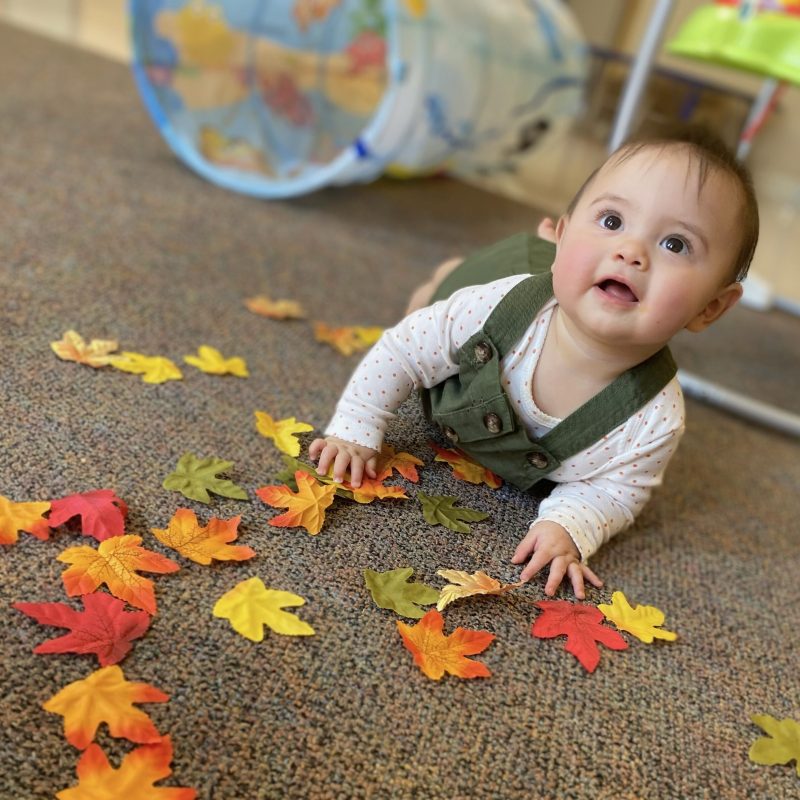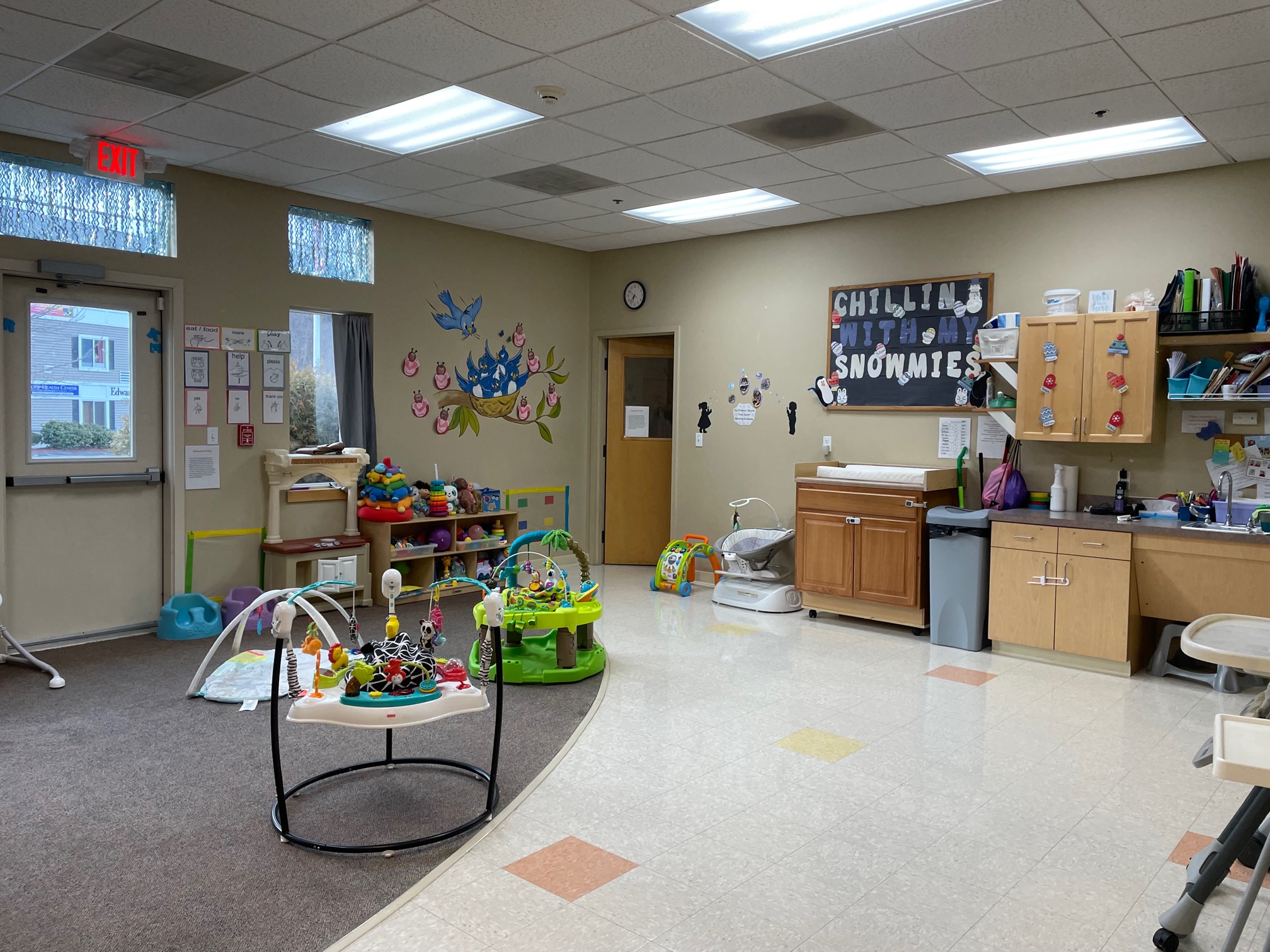8 Weeks – 15 months
Cubs Cave & Nesting Tree
Why choose us?
Clean
All toys in the infant room are disinfected as they are used and at the end of the day to prevent the spread of germs. Our low ratio allows for quality time with each child, individually and as a group. Daily activities are based on each child's developmental level. Included in the daily activities are stories being read and songs sung to the children.
healthy Environment
Children receive a personalized daily note to inform you of their day. This will include how often and how much they ate, length of naps, and how often they were changed.
Compassionate
Activities are broken down according to the child's age. Activities are only done when your child is developmentally ready. Children learn at their own pace and rate, we do not force your child to do anything they are not ready for.

Adaptive
We work with the parents to keep their child's current schedule.
Knowledgable teachers
We provide a stimulating and nurturing environment with a low teacher/child ratio. Our infant teachers are very knowledgeable in infant growth and development. All teachers and teaching assistants are First Aid / CPR certified.
Adequate Sleep
Each child can receive the adequate sleep they require in our sleeping area. This area is gated off to keep crawling and walking babies from disrupting your child's rest time.
0 Months – 4 Months
What we work on
Muscular Control
We will hold a rattle in front of infant for them to reach and grasp. Placing a toy near the child encourages them to turn their head or hold head up without support and encourages roll.
Seeing
Eye catching items around the room encourages your child to follow and focus (at this age they can see up to 8 inches in front of them).
Hearing
Talking and singing to child during holding and feeding time. Musical tapes are also provided.
Emotions
Snuggling, singing and conversing with the child provide pleasant experiences.
4 Months – 8 Months
What we work on
Muscular Control
Infants are encouraged to sit in a safe sitting space with assistance. In time this will result in the infant sitting with out assistance. We hold the infant in a standing position or place them in an exercise–saucer to strengthen leg muscles and prepare them for crawling and walking. We encourage crawling. Infants play banging games with blocks, bells and balls
Seeing
Pictures are provided in a variety of designs and colors to stimulate new looking.
Hearing
Quiet space is provided for child to hear his/her own voice. Talking and singing is directed towards the child to encourage eye contact. Listening games are played with shakers or sand–cans to encourage the child to turn toward noises heard.
Emotions
We are loving, cuddling, holding and playing as much as possible with each child.
8 Months – 12 Months
What we work on
Muscular Control
Standing is encouraged with assistance and push toys are provided for your child to hold on to. Older infants begin to take steps. This is encouraged by providing an obstacle free environment. Provide objects to pinch and lift such as cheerios, crackers, toys, dolls, balls and small blocks (objects are not small enough to swallow). We may now engage your child in finger–painting
Emotions
We share infant feelings by reflecting their emotions. Infants show pride in their accomplishments and independence and we encourage this through praise. We encourage self feeding and provide ample time and patience.
Social
We play guessing games such as “Can you do this” wave, clap, etc. Ample toys are provided for infants to engage in play. Children reach and touch other children to show interaction
12 Months – 14 Months
What we work on
Muscular Control
Infants actively move from one activity to another. A variety of materials are provided to keep your child engaged and stimulated. Walking alone is encouraged. Push toys or a hand are provided if the child needs or wants assistance. Ball games are played to encourage throwing, rolling and catching objects.
Seeing
Children start visual searches in a room and begin making observation. Space is provided with few visual obstructions so children can scan and make observations from a distance.
Emotions
Your child‘s emotions are crucial at the young toddler age. We determine cause and respond to excitement, delight, sadness, tantrums, etc. Constant praise is given to each child for controlling their own behavior, which reinforces desire for appropriate behavior.
Eye/Hand Coordination
Art projects are introduced by encouraging holding a paint brush or using crayons.
Self
Sharing is encouraged at this age because your child only understands his/her own viewpoints and we understand they are egocentric.
Language
Children begin to babble, repeat and practice words. We encourage use of words rather than actions and their repeated work and expand it into sentence form, eg. “dog” Yes, do you hear the dog barking? We consistently label objects in pictures and books.
Ready for Transition
At 13.5 months we start transitioning your child in to the toddler room. This consist of short visits with their new teacher and friends. We will extend visits every week until they reach 15 months. This process works well and we find if we ease them in to the room it is not such a shock.
What we ask of you
- We ask that you provide us with a tentative schedule, keeping in mind that as your child grows his/her schedule will change rapidly.
- We ask that you keep an adequate supply of bibs, diapers, wipes, and diaper ointment, and at least three changes of clothing.
- We ask that you bring in a sleep safe sleep sack (a blanket if over 12 months). This will be sent home at the end of each week to be washed.
